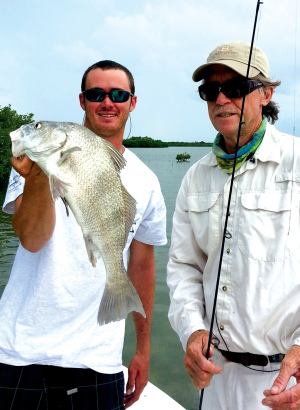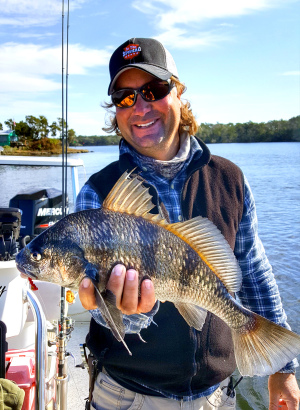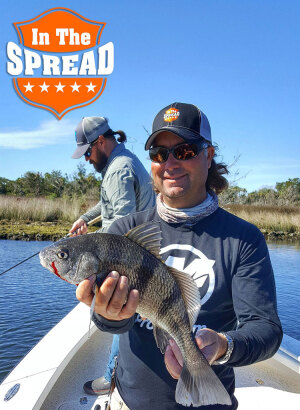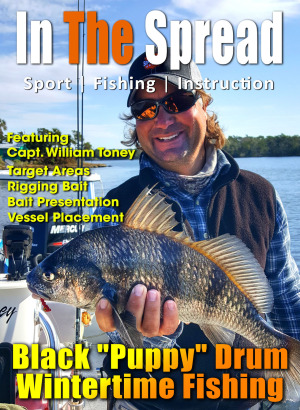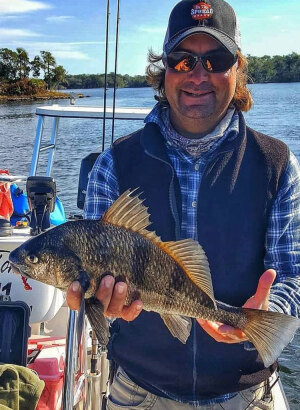Winter transforms Florida's Nature Coast into prime black drum territory. Captain William Toney reveals where these underrated fish congregate in deep holes and warm river inlets, plus the best baits and techniques to target both tasty "puppy drum" and trophy-sized specimens during the colder months.
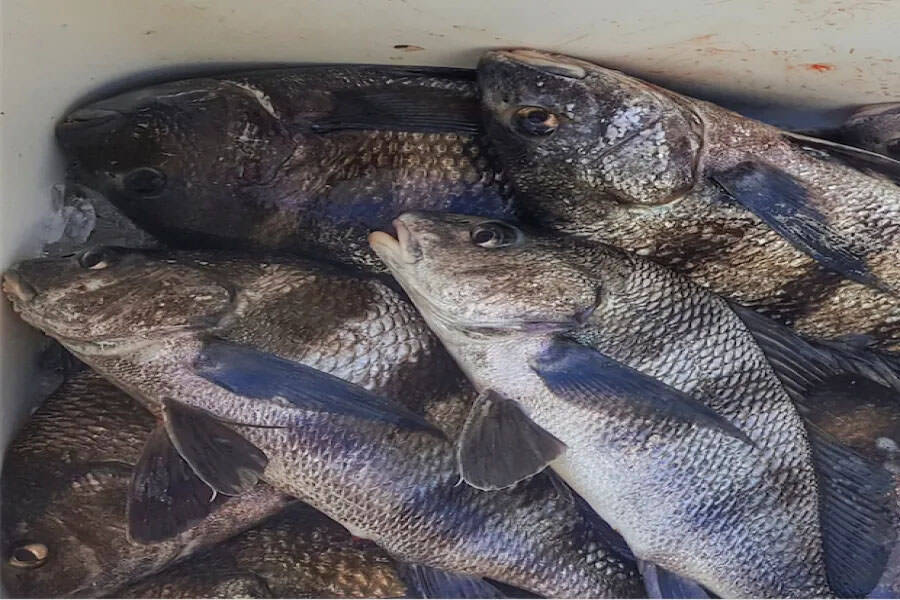
Winter Black Drum Fishing - Capt William Toney
Winter Black Drum Fishing Techniques for Florida Waters
In the world of inshore fishing, there's an unsung hero that emerges, especially during the colder months - the black drum. Often overshadowed by more popular species, black drum fishing offers an exhilarating experience for anglers, particularly in the winter. Capt William Toney, a seasoned fisherman, shares his insights and experiences on targeting these unique fish during the chillier season.
The Black Drum: A Winter Delight
The black drum, a robust and resilient species, displays a fascinating behavioral pattern, particularly during the colder months of the year. As temperatures drop, these fish instinctively seek out warmer waters to maintain their physiological needs. This instinctual migration leads them into the serenity of rivers and estuaries, offering a warmer and more stable environment compared to the open sea.
One of the most notable behaviors of the black drum during winter is their migration into areas like the rivers along Nature Coast of Florida. This natural phenomenon is especially pronounced during cold fronts when the temperature differences between open waters and inshore areas become more distinct. The Homosassa and Crystal rivers, with there unique geographical and ecological characteristics, provides an ideal refuge for these fish. The rivers mix of freshwater and saltwater, along with its rich biodiversity, offers an abundant supply of food and shelter, making it an attractive destination for black drum seeking respite from the harsh ocean environment.
For inshore fishing enthusiasts, this migration presents a golden opportunity. As black drum congregate in these warmer waters, their increased numbers and predictable locations make them more accessible to anglers. The winter months transform these areas into hotspots for black drum fishing, attracting both seasoned and novice fishermen alike. The presence of black drum in these inshore waters not only provides an exciting fishing experience but also allows a closer observation of their behaviors and patterns, contributing to a deeper understanding of this fascinating species.
Moreover, the migration of black drum into our rivers during winter underscores the importance of these ecosystems as vital habitats for marine life. It highlights the interconnectedness of different marine environments and the role of seasonal changes in the life cycle of aquatic species. Inshore areas serve as crucial sanctuaries for marine species during challenging environmental conditions, emphasizing the need for their protection and conservation.
The wintertime migration of black drum into warmer inshore waters such as those along the Nature Coast is a remarkable natural event. It not only provides exceptional fishing opportunities but also showcases the adaptability and resilience of these fish. This phenomenon also underscores the ecological significance of rivers and estuaries as essential habitats for marine life, especially during environmental extremes.
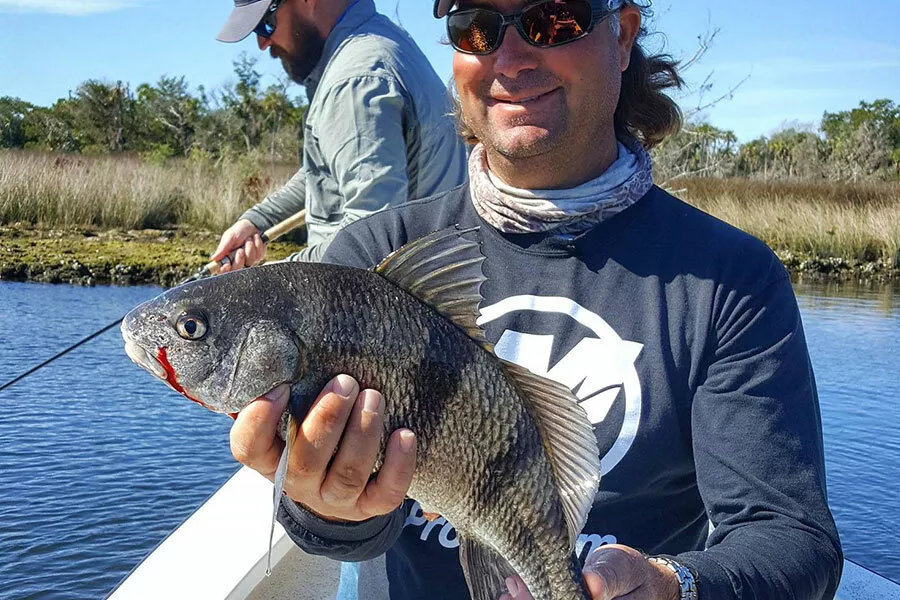
Where to Find Them
The pursuit of black drum, particularly during the winter months, is akin to a strategic game of hide and seek. The key to success in this endeavor lies in understanding and locating their preferred habitats. Among these, deep holes with hard shell bottoms emerge as prime locales. These areas, often characterized by their deeper waters and substrates of shell beds or compacted sand, offer the black drum a unique environment that caters to their needs.
Why do black drum favor these deep holes with hard shell bottoms? Firstly, these areas provide a refuge from the harsher conditions and predators found in shallower or more open waters. The depth offers a stable temperature, a crucial factor during colder months, and the hard bottom provides a rich foraging ground. Black drum, with their bottom-feeding habits, find an abundance of food such as mollusks, crustaceans, and small fish in these environments. This abundance of food, combined with the safety offered by the depth and terrain, makes these areas ideal for black drum to congregate, feed, and grow.
For anglers, understanding this habitat preference is crucial. It transforms these deep holes into hotspots for black drum fishing. Anglers equipped with this knowledge can focus their efforts, increasing their chances of a successful catch. The method of fishing in these areas often involves tactics that cater to the black drum's bottom-feeding nature, such as using baits that rest on or near the seabed, where these fish are most likely to feed.
Furthermore, the allure of the black drum extends beyond the mere challenge of the catch. Their size plays a significant role in their appeal to anglers. The "puppy drum," a colloquial term for smaller black drum, are particularly sought after. These younger fish, typically more tender and flavorful, are compared favorably to their cousin, the redfish, in culinary circles. The taste of the puppy drum is renowned for its mild, sweet flavor and a texture that lends itself well to a variety of cooking methods. This makes them not just a trophy for anglers in terms of the sport but also in terms of the culinary rewards they offer.
The black drum's size range also adds to the excitement of fishing for them. While the smaller ones are celebrated for their taste, the larger black drum provide a more robust and challenging fishing experience. Catching a large black drum requires skill, patience, and often, a bit of a struggle, making the victory all the more satisfying.
In essence, the pursuit of black drum, particularly in their favored habitats of deep holes with hard shell bottoms, is a multifaceted experience. It combines the thrill of the hunt, the satisfaction of understanding and leveraging environmental patterns, and the delight of a culinary treat. This rich combination of factors is what makes fishing for black drum a uniquely rewarding venture for anglers.
Bait and Tackle: A Strategic Approach
The art of bait selection for black drum fishing embodies the principle that sometimes, simplicity is key. Among the various options, shrimp stands out as a particularly effective choice. This preference is rooted in the natural diet of black drum, which includes a variety of crustaceans, with shrimp being a prominent component. The use of shrimp as bait taps into the black drum's instinctual feeding habits, making it a powerful lure. The scent, movement, and familiar texture of shrimp are almost irresistible to black drum, making it a go-to bait for many seasoned anglers.
However, when targeting the larger black drum, which can reach impressive weights of up to 30lbs, the bait choice shifts to something more substantial: cracked blue crab. These larger specimens require a more enticing and substantial offering. Cracked blue crab, with its potent aroma and meaty consistency, provides just that. The robustness of this bait not only withstands the powerful bite of a large black drum but also appeals to their preference for larger prey. This makes it an ideal choice for anglers aiming to reel in the bigger, more challenging members of the species.
The hunting grounds for these larger black drum often lie near areas like the St. Martins Keys, where they can sometimes be observed from a distance. This visibility adds an intriguing dimension to the fishing experience. Anglers have the unique opportunity to spot their target, gauge its size, and strategically plan their approach. This aspect of sight-fishing requires not just the right bait but also a keen eye and a strategic approach in terms of positioning and casting.
The challenge of catching these giants is further heightened by their size and strength. Hooking a large black drum is just the beginning; the real test lies in the ensuing battle. These fish are known for their powerful runs and stamina, turning the act of reeling them in into a test of skill and endurance. It's a thrilling experience that demands patience, finesse, and the right equipment – from the strength of the line to the durability of the rod and reel.
When fishing for black drum, the choice of bait plays a critical role in the success of the endeavor. While shrimp serves as a universally effective bait for most sizes, the larger black drum often require the more substantial and enticing cracked blue crab. This distinction in bait choice, combined with the unique challenges presented by different sizes of black drum, makes for a dynamic and exciting fishing experience. Anglers must not only choose their bait wisely but also adapt their techniques and gear to suit the specific challenges posed by their quarry, whether it's the more accessible smaller black drum or the formidable larger ones near the St. Martins Keys.
Regulations and Conservation
Understanding and adhering to the regulations established by the Florida Fish and Wildlife Conservation Commission (FWC) is not just a legal responsibility for anglers but also a crucial aspect of ethical and sustainable fishing practices. These regulations, designed to protect fish populations and ensure their long-term health, specify legal sizes and catch limits for various species, including the black drum.
For black drum, the FWC has set a slot size limit of 14" to 24". This means that anglers are permitted to keep black drum that fall within this size range. The rationale behind such slot limits is twofold. Firstly, it ensures that the youngest, most juvenile fish are left to grow and mature, thus contributing to the continuation of the species. Secondly, it helps in preserving the breeding population, as larger fish are often the most reproductively capable. This approach to regulation is a key aspect of fisheries management, balancing the needs of the fishing community with the need to maintain healthy fish populations.
Additionally, the FWC allows anglers to keep a limit of five black drum per person. This bag limit is designed to prevent overfishing and ensure that everyone has a fair opportunity to enjoy the resource. It encourages anglers to be selective in their catch, ideally keeping only what they need, thereby promoting responsible and sustainable fishing habits.
While it's legally permissible to keep one black drum over 24", conservation-minded practices suggest a different approach. Larger black drum, often the breeders, play a vital role in the ecosystem. They contribute significantly to the species' population by producing a higher number of offspring. Releasing these larger fish back into the water supports the health and sustainability of the black drum population. Additionally, from a culinary standpoint, the meat of larger black drum is often considered less palatable than that of smaller, younger fish. Their texture can be tougher and the flavor less delicate, diminishing their appeal on the dinner table.
The practice of catch and release, especially with larger black drum, is more than a conservation strategy; it's a reflection of an angler's commitment to preserving the aquatic ecosystem. By adhering to these regulations and adopting conservation-minded practices, anglers play an active role in sustaining the black drum population for future generations. It's a holistic approach that balances the joy and sport of fishing with the responsibility of stewardship over the marine environment. Such practices ensure that the black drum, a valuable and cherished species, continues to thrive in Florida's waters, providing enjoyment and sustenance to anglers for years to come.
The Culinary Aspect
The culinary reputation of black drum, particularly those within the slot size of 14" to 24", is a significant aspect of their appeal to anglers and seafood enthusiasts alike. These smaller black drum, often termed "puppy drum," are celebrated for their delectable taste, a key factor that makes them a sought-after catch. The meat of these younger fish is known for its mild, sweet flavor and a delicate, flaky texture that is highly versatile in the kitchen. This versatility allows for a variety of preparation methods - from grilling and frying to baking and steaming - each method bringing out a different aspect of its delightful flavor profile. The appeal of puppy drum extends beyond the thrill of the catch; it's also about the anticipation of a delicious meal, making them a favorite among both recreational anglers and gourmet cooks.
In contrast, the larger specimens, often referred to as "big black drum," present a different kind of appeal. While they may not be as celebrated for their taste - with the meat sometimes becoming tougher and less flavorful as they age - they more than compensate for this in the sporting challenge they offer. Big black drum can grow to substantial sizes, sometimes exceeding 30 lbs, and catching them requires skill, patience, and endurance. These fish are known for their strength and stamina, often putting up a vigorous fight when hooked. This makes them a prized target for sportfishing enthusiasts who relish the challenge and the adrenaline rush of battling a large and powerful fish.
Marauding Predators: An Overview
The role of black drum in the marine ecosystem, particularly as predators, is a critical aspect of their ecological significance. These fish, characterized by their migratory behavior and preference for open waters, are not just a target for anglers but also key players in the aquatic food web.
As predators, black drum occupy an important niche. They primarily feed on benthic organisms like mollusks, crustaceans, and small fish. This diet places them in a vital position within the food chain, controlling the population of their prey species. By preying on these organisms, black drum help maintain the balance in their ecosystem, ensuring that no single species dominates to the detriment of others. This predatory behavior is essential for the health of the benthic community, as it keeps the population of species like crabs, shrimp, and mussels in check.
Black drum's preference for different types of prey at various life stages also contributes to their ecological role. Younger black drum, often found in shallower waters, tend to feed on smaller and more abundant prey. As they grow older and move into deeper waters, their diet shifts to larger, less abundant prey. This change in dietary habits as they grow ensures that they impact a wide range of species within the food chain, contributing to the diversity and balance of the ecosystem.
Furthermore, the migratory patterns of black drum are significant in terms of their ecological impact. Their movement between different habitats at different times of the year ensures that their predatory influence is spread across a wide area. This migration is crucial not only for their survival - as it allows them to exploit different feeding grounds - but also for the ecosystems they enter and leave. Their presence or absence in an area can significantly affect the local species composition and health of the ecosystem.
Black drum also serve as prey for larger marine predators, including sharks and larger game fish. This role as both predator and prey highlights their importance in the marine food web, where they contribute to the flow of energy and nutrients through the ecosystem. Their role as prey also underlines the importance of maintaining healthy black drum populations, as they are a crucial link in the food chain that supports a diversity of marine life.
The ecological role of black drum extends far beyond their value as a sport fish. As predators, they play a pivotal role in maintaining the balance of species in their habitat. Their migratory patterns and dietary habits have far-reaching effects on the health and stability of the marine ecosystems they inhabit. Understanding and appreciating this ecological role is essential for effective conservation and management strategies, ensuring that black drum continue to thrive and contribute to the rich biodiversity of marine life.
Why Choose Winter Black Drum Fishing?
Wintertime black drum fishing presents a unique set of opportunities and experiences, making it a compelling choice for anglers of various interests and skills:
- Unique Challenge: Winter transforms the coastal waters, bringing with it a distinctive fishing environment. During this season, black drum tend to congregate in specific areas, such as warmer river inlets or deep holes with hard shell bottoms. This seasonal behavior pattern creates a fascinating challenge for anglers. It requires a blend of skill, knowledge, and patience to locate and catch these fish. The predictability of their location combined with the variable winter weather conditions adds an exciting dimension to the fishing experience, appealing to those who relish a strategic and rewarding challenge.
- Culinary Delight: The winter months are an excellent time to target the "puppy drum," the smaller, younger black drum known for their delicious taste. These fish are highly valued for their tender, flavorful meat, which is a delight in various culinary preparations. The satisfaction of catching and then preparing a fresh, self-caught meal adds a deeply personal and gratifying element to the fishing experience, making it particularly appealing for those who appreciate the connection between the sport of fishing and the enjoyment of its culinary rewards.
- Conservation-Friendly: Engaging in wintertime black drum fishing, especially when adhering to established regulations, promotes sustainable fishing practices. By following size and catch limits, anglers contribute to the conservation of black drum populations. This responsible approach ensures the long-term health and sustainability of the species, making the activity not just enjoyable but also ethically rewarding. It allows anglers to enjoy the sport while playing an active role in marine conservation efforts.
- Scenic Beauty: The locations where black drum are found during the winter, like the Nature Coast region of West Florida, are often areas of outstanding natural beauty. These fishing spots offer tranquil and picturesque settings, providing a serene escape from the hustle and bustle of everyday life. The scenic beauty of these areas enhances the overall fishing experience, offering a sense of peace and connection with nature. This aspect is particularly appealing to those who value the aesthetic and restorative qualities of outdoor activities.
In summary, wintertime black drum fishing is a multifaceted activity that offers a unique blend of challenges and rewards. From the strategic aspects of locating and catching the fish, the culinary pleasures of cooking your catch, the satisfaction of participating in conservation-friendly practices, to the sheer beauty of the fishing environments, this activity provides a rich and fulfilling experience for anglers.
Final Thoughts
Black drum fishing in winter, as guided by Capt William Toney's expertise, is not just an angling adventure; it's a journey into understanding a unique species, their habitat, and the importance of sustainable fishing practices. Whether it's the thrill of the catch or the anticipation of a delicious meal, black drum fishing is an experience that resonates long after the season ends.

